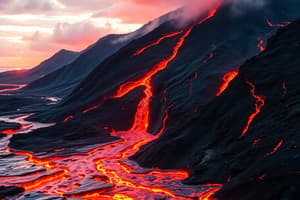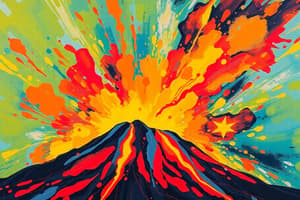Podcast
Questions and Answers
Which characteristic of magma is most closely associated with effusive volcanic eruptions?
Which characteristic of magma is most closely associated with effusive volcanic eruptions?
- Presence of volcanic bombs
- Low viscosity (correct)
- High silica content
- High gas content
Pyroclastic flows are more commonly associated with volcanoes that erupt magma with low silica content.
Pyroclastic flows are more commonly associated with volcanoes that erupt magma with low silica content.
False (B)
What is the primary factor that determines whether a volcanic eruption will be explosive or effusive?
What is the primary factor that determines whether a volcanic eruption will be explosive or effusive?
Silica content of the magma
The 2010 eruption of Mount Merapi in Indonesia caused death and widespread damage due to highly destructive ______ flows.
The 2010 eruption of Mount Merapi in Indonesia caused death and widespread damage due to highly destructive ______ flows.
Match the volcanic hazard with its primary contributing factor:
Match the volcanic hazard with its primary contributing factor:
Which characteristic of magma is most associated with violent volcanic eruptions?
Which characteristic of magma is most associated with violent volcanic eruptions?
Eruptions with low-silica magma are typically associated with pyroclastic flows and widespread devastation.
Eruptions with low-silica magma are typically associated with pyroclastic flows and widespread devastation.
What type of secondary hazard is most directly linked to the availability of surface and groundwater during or after a volcanic eruption?
What type of secondary hazard is most directly linked to the availability of surface and groundwater during or after a volcanic eruption?
The 2016 Kilauea eruption in Hawaii, characterized by ______ magma, resulted in significant property damage but relatively few injuries.
The 2016 Kilauea eruption in Hawaii, characterized by ______ magma, resulted in significant property damage but relatively few injuries.
If a volcano, irrespective of its magma composition, is located in a region with substantial snow and ice cover and is entering a period of increased volcanic activity, which of the following represents the most critical immediate risk to nearby communities?
If a volcano, irrespective of its magma composition, is located in a region with substantial snow and ice cover and is entering a period of increased volcanic activity, which of the following represents the most critical immediate risk to nearby communities?
How does an increase in the availability of surface and groundwater affect the likelihood and impact of lahars in volcanic regions?
How does an increase in the availability of surface and groundwater affect the likelihood and impact of lahars in volcanic regions?
During a volcanic eruption, what role does groundwater play in the formation of lahars?
During a volcanic eruption, what role does groundwater play in the formation of lahars?
What hydrometeorological factor significantly contributed to the severity of lahars following the 1991 Mount Pinatubo eruption?
What hydrometeorological factor significantly contributed to the severity of lahars following the 1991 Mount Pinatubo eruption?
Which of the following describes the most direct impact of lahars on communities located near a volcano?
Which of the following describes the most direct impact of lahars on communities located near a volcano?
Consider a scenario where a volcano is located in a region experiencing both heavy rainfall and rapid snowmelt. What is the most likely primary consequence?
Consider a scenario where a volcano is located in a region experiencing both heavy rainfall and rapid snowmelt. What is the most likely primary consequence?
How does the chemical composition of magma indirectly affect earthquake risks?
How does the chemical composition of magma indirectly affect earthquake risks?
The availability of surface and ground water does not influence the severity of damage from earthquakes.
The availability of surface and ground water does not influence the severity of damage from earthquakes.
What geological phenomenon can occur in water-saturated soil during an earthquake, leading to increased damage?
What geological phenomenon can occur in water-saturated soil during an earthquake, leading to increased damage?
Disaster risks from seismic activity are not _______ across different locations, due to variations in factors such as water availability and local soil conditions.
Disaster risks from seismic activity are not _______ across different locations, due to variations in factors such as water availability and local soil conditions.
Imagine two locations with identical building structures. Location A is situated on dry, compact soil, while Location B is on water-saturated, loose soil. If an earthquake of equal magnitude strikes both locations, which area would likely experience more severe damage, and why?
Imagine two locations with identical building structures. Location A is situated on dry, compact soil, while Location B is on water-saturated, loose soil. If an earthquake of equal magnitude strikes both locations, which area would likely experience more severe damage, and why?
Flashcards
Low Silica Magma
Low Silica Magma
A type of magma that is less viscous and leads to gentle, effusive eruptions.
High Silica Magma
High Silica Magma
More viscous magma that causes violent eruptions, including pyroclastic flows.
Pyroclastic Flow
Pyroclastic Flow
A fast-moving current of hot gas and volcanic matter that causes widespread destruction.
Lahars
Lahars
Signup and view all the flashcards
Impact of Eruptions
Impact of Eruptions
Signup and view all the flashcards
Volcanic Eruption Types
Volcanic Eruption Types
Signup and view all the flashcards
Effects of Low Silica Magma
Effects of Low Silica Magma
Signup and view all the flashcards
Destructive Nature of High Silica Magma
Destructive Nature of High Silica Magma
Signup and view all the flashcards
Lahar Triggers
Lahar Triggers
Signup and view all the flashcards
Impact of Lahars
Impact of Lahars
Signup and view all the flashcards
Availability of Surface Water
Availability of Surface Water
Signup and view all the flashcards
Disaster Risk Increase
Disaster Risk Increase
Signup and view all the flashcards
Lahars and Property Damage
Lahars and Property Damage
Signup and view all the flashcards
Sources of Lahars
Sources of Lahars
Signup and view all the flashcards
1991 Mount Pinatubo Example
1991 Mount Pinatubo Example
Signup and view all the flashcards
Factors Affecting Earthquake Damage
Factors Affecting Earthquake Damage
Signup and view all the flashcards
Magma Composition
Magma Composition
Signup and view all the flashcards
Impact of Water on Earthquake Damage
Impact of Water on Earthquake Damage
Signup and view all the flashcards
Liquefaction
Liquefaction
Signup and view all the flashcards
Geological Characteristics
Geological Characteristics
Signup and view all the flashcards
Study Notes
Chemical Composition of Magma (Nature of Hazard)
-
Magma type determines if an eruption is explosive or effusive
-
Low silica magma:
- Less viscous (thick, sticky)
- Gentle, effusive eruptions
- Lava flows far, damages infrastructure over large areas
- Rarely kills people (they can avoid lava flows).
- Example: 2016 Kilauea eruption (Hawaii)
- 24 injuries
- 600 homes destroyed
- $800 million damage
-
High silica magma:
- More viscous
- Violent eruptions
- Highly destructive pyroclastic flows (widespread damage, injuries, and deaths)
- Volcanic bombs may strike people, causing injuries and death.
- Example: 2010 Mount Merapi eruption (Indonesia)
- Pyroclastic flow traveled 3 km
- Volcanic bombs spread over 10 km
Availability of Surface and Groundwater (Vulnerable Conditions)
- Greater availability of surface and groundwater increases the likelihood of lahars.
- More people and buildings are exposed, increasing disaster risk.
- Sources:
- Rapid melting of snow and ice on volcano's summit (before/after eruption)
- Groundwater released through cracks and fractures during eruption
- Existing lakes and rivers
- Heavy rainfall
- Lahars bury and destroy property, increasing injuries and deaths.
- Example: 1991 Mount Pinatubo eruption (Indonesia)
- Many lahars following the eruption
- Heavy rain (monsoon season)
- More than 100,000 homes destroyed
Studying That Suits You
Use AI to generate personalized quizzes and flashcards to suit your learning preferences.




